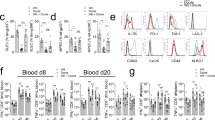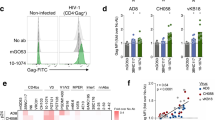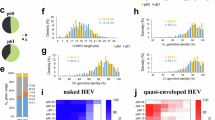Abstract
IN medically important infections with cytopathic viruses, neutralizing antibodies are generated within 6–14 days. In contrast, such protective antibodies appear late (50–150 days) after infection with immunodeficiency virus (HIV) and hepatitis B virus (HBV) in humans, or lymphocytic choriomeningitis virus (LCMV) in mice1–6. However, during these infections, non-neutralizing antibodies appear much earlier2,6,7. It has been proposed that T cells suppress antibody responses generally and against viruses in vitro6,8–10. Here we show that the suppression of neutralizing-antibody responses in LCMV infections in mice is due to selective infection of neutralizing-antibody-producing B cells by this non-cytopathic virus, and their subsequent destruction by virus-specific cytotoxic T cells. Such specific B-cell elimination that leads to a delay in neutralizing-antibody production could help to establish persistent virus infections by non-cytopathic viruses.
This is a preview of subscription content, access via your institution
Access options
Subscribe to this journal
Receive 51 print issues and online access
$199.00 per year
only $3.90 per issue
Buy this article
- Purchase on SpringerLink
- Instant access to full article PDF
Prices may be subject to local taxes which are calculated during checkout
Similar content being viewed by others
References
Moore, J. P., Cao, Y. Ho, D. D. & Koup, R. A. J. Virol. 68, 5142–5155 (1994).
Alberti, A. et al. Lancet I, 1421–1424 (1988).
Robert-Guroff, M., Brown, M. & Gallo, R. C. Nature 316, 72–74 (1985).
Weiss, R. A. et al. Nature 316, 69–71 (1985).
Lehmann-Grube, F. Virol. Monogr. 10, 1–173 (1971).
Battegay, M. et al. J. Immunol. 151, 5408–5415 (1993).
Koup, R. A. & Ho, D. D. Nature 370, 416 (1994).
Gershon, R. K. & Kondo, K. Immunology 18, 723–737 (1970).
Dorf, M. E. & Benacerraf, B. Annu. Rev. Immunol. 2, 127–157 (1984).
Barnaba, V., Franco, A., Alberti, A., Benvenuto, R. & Balsano, F. Nature 345, 258–260 (1990).
Buchmeier, M. J., Welsh, R. M., Dutko, F. J. & Oldstone, M. B. A. Adv. Immunol. 30, 275–331 (1980).
Kägi, D. et al. Nature 369, 31–37 (1994).
Leist, T. P., Rüedi, E. & Zinkemagel, R. M. J. Exp. Med. 167, 1749–1754 (1988).
Odermatt, B., Eppler, M., Leist, T. P., Hengartner, H. & Zinkernagel, R. M. Proc. Natl Acad. Sci. USA 88, 8252–8256 (1991).
Borrow, P., Evans, C. F. & Oldstone, M. B. A. J. Virol. 69, 1059–1070 (1995).
Bruns, M., Cihak, J., Müller, G. & Lehmann-Grube, F. Virology 130, 247–251 (1983).
Whitton, J. L. et al. J. Virol. 63, 4303–4310 (1989).
Schulz, M. et al. Eur. J. Immunol. 19, 1657–1667 (1989).
Moskophidis, D., Cobbold, S. P., Waldmann, H. & Lehmann-Grube, F. J. Virol. 61, 1867–1874 (1987).
Staerz, U. D., Karasuyama, H. & Garner, A. M. Nature 329, 449–451 (1987).
Shinohara, N., Watanabe, M., Sachs, D. H. & Hozumi, N. Nature 336, 481–484 (1988).
Raychaudhuri, S. & Morrow, W. J. W. Immunol. Today 14, 344–348 (1993).
Hisatsune, T., Nishijima, K., Kohyama, M., Kato, H. & Kaminogawa, S. J. Immunol. 154, 88–96 (1995).
Chesnut, R. W., Colon, S. M. & Grey, H. M. J. Immunol. 129, 2382–2388 (1982).
Lanzavecchia, A. Annu. Rev. Immunol. 8, 773–793 (1995).
Bachmann, M. F. et al. Eur. J. Immunol. 24, 2128–2236 (1994).
Mims, C. A. The Pathogenesis of Infectious Disease (Academic, London, 1987).
Gobet, R., Cerny, A., Rüedi, E., Hengartner, H. & Zinkernagel, R. M. Exp. Cell Biol. 56, 175–180 (1988).
Henle, W. & Henle, G. Cancer Res. 41, 4222–4225 (1981).
Author information
Authors and Affiliations
Rights and permissions
About this article
Cite this article
Planz, O., Seiler, P., Hengartner, H. et al. Specific cytotoxic T cells eliminate cells producing neutralizing antibodies. Nature 382, 726–729 (1996). https://doi.org/10.1038/382726a0
Received:
Accepted:
Issue date:
DOI: https://doi.org/10.1038/382726a0
This article is cited by
-
Viral subversion of B cell responses within secondary lymphoid organs
Nature Reviews Immunology (2018)
-
A non-retroviral RNA virus persists in DNA form
Nature (1997)
-
Immune responses throughout hepatitis C virus (HCV) infection: HCV from the immune system point of view
Springer Seminars in Immunopathology (1997)
-
Comparative features of hepatitis C virus infection in humans and chimpanzees
Springer Seminars in Immunopathology (1997)



